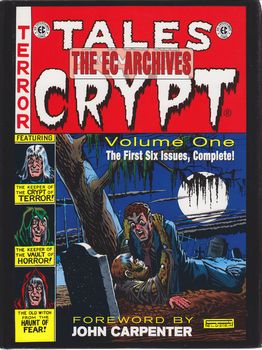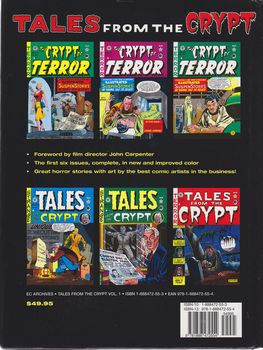volume 1, issues 1-6
| série: | Tales from the crypt |
| dessinateur / scénariste: | Collectif |
| éditeur: | Gemstone EO 2006 |
| genre: | Horreur |
| classement: | biblio520 |
| date: | 2006 |
| format: | hardcover, with jacket |
| état: | TBE/N |
| valeur: | 40 € |
| critère: | ** |
| remarques: | >> archive, see also dossier 463B US comics ** are the best horror stories 1/ acknowledgements by Russ Cochran, publisher, to William M. Gaines who published in the fifties one of the most successful lines of comic books in history Al Feldstein was his best writer and artist for horror stories, both of them created the famous EC (Entertaining Comics, later on Educational Comics) Harvey Kurtzman (Mad Magazine) and Johnny Craig added to the team their talents followed by many other talentuous artists such as Jack Davis, Graham Ingels, Wallace Wood, Joe Orlando, Al Williamson, John and Marie Severin, Joe Kubert however due to the restrictions imposed by the Comic Code, Gaines was forced to draw the final curtain on EC comic books in 1956 most of the original coloring of these stories is the work of colorist Marie Severin and although all of these stories have been re-colored for this new edition, her style of coloring was followed to retain the integrity of the original EC comic books 2/ foreword by John Carpenter who read during his youth in the fifties with EC comics the legendary stories of Bill Gaines such as "weird science" and "tales from the crypt" (containing entrails, monsters, demons,death, the undead, the ancient and new dead, etc), this little comic book was pulp horror at its finest 3/ the evolution of "tales from the crypt" Bill Gaines published the first issue of "International Comics" in 1947 sales were lackluster (not in great demand) in 1948 the title was changed to "International Crime Patrol", then "Crime Patrol" with a new artist: Johnny Craig who introduced a new character: captain Crime sales started to increase later on Al Feldstein stepped in together with Graham Ingels, Gaines was now straining toward what would be called the "new trend" in comics and with issue 17, Crime Patrol was replaced by a new title "the crypt of terror" in which Al Feldstein introduced his narrator, the crypt-keeper (followed later on by the vault-keeper and the old witch) with the first story "return from the grave", the die was cast and new artists were engaged (George Roussos, John Alton, Jack Kamen and Ben Oda) with this new logo the stories would become EC's most popular comic books 4/ the crypt of terror, issue 17, april-may 1950 cover art: Johnny Craig, colors: Marie Severin a) death must come by Al Feldstein ** (the wish for eternal life) b) the man who was death by an unknown artist (the life of a executioner c) the corpse nobody knew by George Roussos (a detective story) d) curse of the full moon by Johnny Craig (the story of a werewolf) >> p. 42 a photo showing Johnny Craig, Al Feldstein and Bill Gaines (1949) 5/ the crypt of terror, issue 18, june/july 1950 a) the maestro's hand by Al Feldstein ** (the moving hand) b) the living corpse by Wally Wood (the corpse at the morgue coming to life again) c) madness at Manderville by Harvey Kurtzman (the mad one is not the one expected) d) mute witness to murder by Johnny Craig ** (a woman saved by a heart-attack) 6/ the crypt of terror, issue 19, August/september 1950 a) ghost ship by Al Feldstein (marooned on a ghost-ship) b) the hungry grave by Graham Ingels (ready for a dead body) c) cave man by Johnny Craig ** (the expedition in the Swiss Alps to find a specimen of Neanderthaler) d) the (white) Zombie by Johnny Craig (the voodoo drums) >> p. 78 the evolution of crypt logo the first "trend titles": the crypt of terror, the vault of horror and the haunt of fear and as per issue 20 the tales from the crypt >> p. 94 the creation of comic book pages first come the writer with a script containing dialogue, caption (= heading or short title) and a brief description of the action, then the laying out was put on the page by the editor, next would be to pencil the drawings and the pencil to be inked with or without color and finally the lettering would be added >> p. 110 in the beginning of the foray two further titles were created: "Two-Fisted Tales" and "Frontline Combat" 7/ tales from the crypt, issue 20, october/november 1950 a) the thing from the sea by Al Feldstein (the nightmare of cabin 13) b) a fatal caper by Jack Kamen ** (the book on magic) c) Rx...death by Graham Ingels ** (the brother who is being digested alive) d) impending doom by Johnny Craig (the gravestone cutter) >> p. 144 the work condition of the artists at that time when publishing comic books, most of them often becaming free-lancers 8/ tales from the crypt, issue 21, december 1950/january 1951 cover art: Al Feldstein, colors: Marie Severin >> p. 146 description of the Comic Code used by the Association of Comics Magazine Publishers which believes in decency and good taste a) a shocking way to die by Al Feldstein ** (the new life after a death sentence) b) terror ride by Wally Wood (in the amusement park) c) house of horror by Harvey Kurtzman d) death suited him by Graham Ingels ** (the cursed poisoned tuxedo) 9/ tales from the crypt, issue 22, february/march 1951 a) the thing from the grave by Al Feldstein ** (the dead one saving the life of the living one) b) blood type "V" by Graham Ingels (transfusion with a vampire's blood) c) death's turn by Jack Kampen ** (the new type high-speed roller coaster) d) the curse of the Arnold clan by Johnny Craig (Arnold's musket and powder-horn) or the vault of horror (when crypt-keeper meets vault-keeper) >> p. 198 the subscription of one year for the magazine would cost 75 cents for six issues >> p. 212 the problem with the coloring of comic books in the 1950s >> a good achievement of the tales, some are abit smooth and naive horror stories, despite the fact that the design was not always much elaborate but reasonably made for the price asked for Information the EC (Entertaining Comics) Archives is an effort to preserve for future generations of comic art aficionados and scholars, what is generally considered to be the greatest line of comic books ever published, the EC line, originally published as regular 10-cents comic books from 1950 through 1955 these comic books were important for a number of reasons: - they brought a new, higher level of writing and artwork to the medium of the comics - they were popular with young adults as well as children (one large contingent of EC readers was the servicemen serving in the Armed Forces), they were the first to identify and elevate the comic book artists to "star status" with the readers and they provoked a huge outcry from public-minded groups (and a certain psychiatrist) who maintained that horror comics in particular and most comic books in general, were a root cause for the explosion of juvenile delinquency in the 1950s the business of comic books has always been very initiative when a publisher had great success with a certain type of comic book, like Superman for instance other publishers were quick to jump on the bandwagon with their own versions in the 1940s and into the early 1950s, most homes did not yet have television sets and the millions of young readers took to the comic book with a voracious appetite soon after Superman flew through the comic book skies, dozens of other costumed superheroes, each with their own special powers, appeared on the newsstands of America and were gobbled up by this new generation of readers EC Comics began by initiating the most succesful comic books of the day the themes of EC Comics started with "funny animal" stories like "tiny tot comics" (your first comic book) and followed the trend of the western, romance and crime comic books of the late 1940s, until, in 1950, publisher Bill Gaines and editor/writer/artist Al Feldstein struck out in a new direction: horror and science fiction comics within a year the sales of their new titles spawned hundreds of other imitators as horror and science fiction became the "new trend" in comic books the team of Gaines and Feldstein created and produced the horror titles: - tales from the crypt, the vault of horror and the haunt of fear - science fiction/fantasy titles - weird science and weird fantasy as well as stories with the famous EC "twist endings" in: - Crime SuspenStories and Shock SuspenStories their success with these titles enabled them to try a new experiment, the first humorous EC Comic written and edited by Harvey Kurtzman, the new book was called MAD MAD ran 23 issues as a ten-cent comic book before becoming an iconic magazine and eventually developing into an American institution |
| couvertures: |   |
Copyright 2008 - 2025 G. Rudolf
